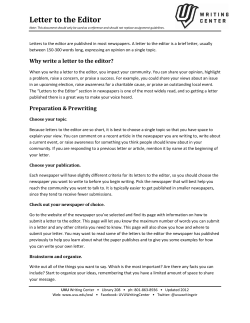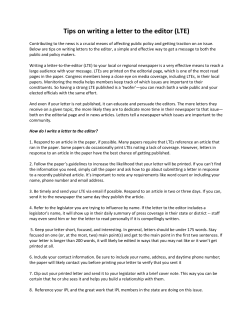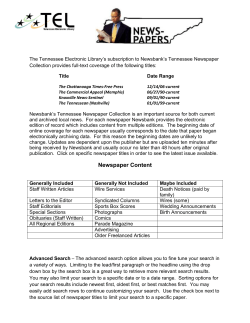
How to write a ‘letter to the editor’
PO Box 1128 NIGHTCLIFF NT 0810 33 Bayfield Rd MALAK NT 0812 ph: 08 89482665 fax: 08 89484590 email: graham@ntcoss.org.au www.ntcoss.org.au How to write a ‘letter to the editor’ Introduction The ‘letters to the editor’ page is one of the most widely-read pages in a newspaper, and papers in the NT appear to struggle to find enough letters of reasonable quality to fill their page. Writing a letter to the editor is a useful way of gaining free publicity for the aims and policy positions of your organisation. NTCOSS has enjoyed considerable success with getting letters to the editor published using the following techniques: Be very clear about the point of your letter. Write the purpose of your letter in one simple sentence before you draft the letter: ‘I want to support the introduction of a floor price on alcohol’, or ‘I want the government to abandon the 130k speed limit.’ As you draft your letter make sure you stay clearly on this track. If you letter rambles on, or contains irrelevant material, it is less likely to get published. Read the ‘letters to the editor’ policy Look for a paragraph in small type somewhere on the letters page which will advise of the paper’s preferred word length for letters, and may provide other limitations. Make sure your letter conforms to these requirements Cater to the style of the particular newspaper you are targeting Explore the ‘culture’ of the letters page in the newspaper you are targeting. Editors like their pages to have a consistent style, so look to see what they are publishing and adopt a similar style. Tabloid newspapers (e.g. NT News, Centralian Advocate) like to run short (150 words) and punchy letters written in simple language and expressing a strong view. Broadsheet newspapers like The Australian or the Sydney Morning Herald tend to run longer letters (300 words or more) written in more sophisticated language and expressing positions which can sometimes be quite complex. If your target newspaper publishes letters which include informal terms like ‘battler’, ‘unique Territory lifestyle’, or ‘do-gooder’ then adopt this style in your letter writing. Page 1 of 1 Use an article or letter that has appeared in the same paper as a ‘hook’ for your letter Newspapers are self-referential and like to think that they set the agenda. They are often happy to publish letters which refer to something that appeared earlier in their paper. If you are using this technique cite the earlier article. You can also write in to commend an editorial which the paper has published, thus further prolonging the story. Don’t be personal or abusive. Stick to the issue under discussion. Resist the temptation to make personal criticisms of those who hold alternative views. Your letter will look more thoughtful and considered. Before you submit your letter, read it out aloud to someone else If you can’t read a letter aloud so that it sounds smooth and fluent, then some redrafting is probably needed. SOME BRIEF TIPS As a general rule, keep your sentences short and your language simple. Make your letter clear and crisp. Letters about current issues have a better chance of being published. Use a snappy phrase or ‘sound bite’ to help your letter to stand out from the others. Use active language Don’t be openly abusive - don’t engage in personal abuse – “play the ball” Avoid ‘bad’ language Get the organisations CEO to sign the letter under their title. Include a title for your letter if you can think of something catchy. It will usually get changed for publication, but will help attract the editor’s eye initially. Read your letter out aloud to someone else before you submit it. (fluency check) On the following pages are a number of letters which NTCOSS has had published in the NT News Page 2 of 1 Page 3 of 1
© Copyright 2025





















